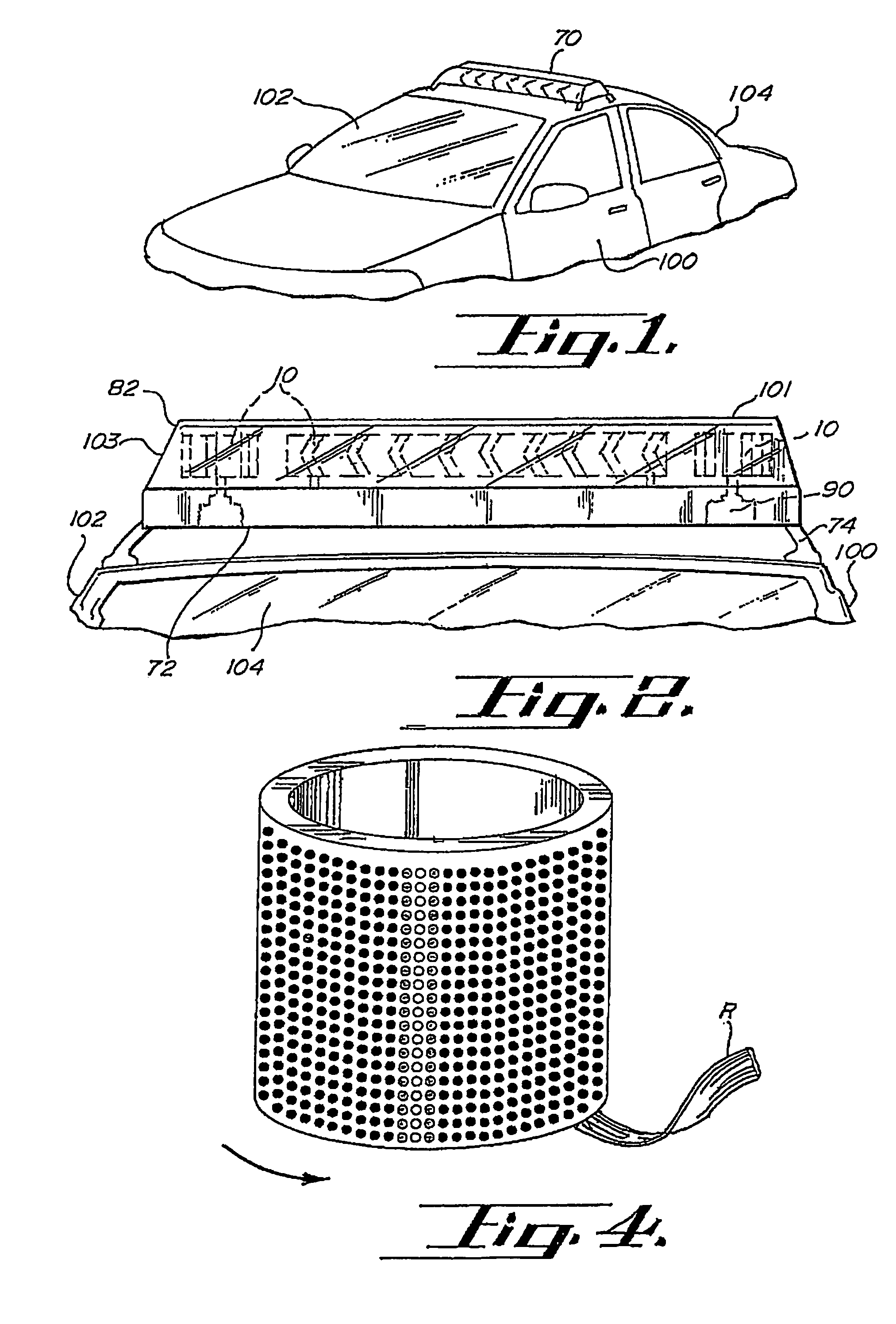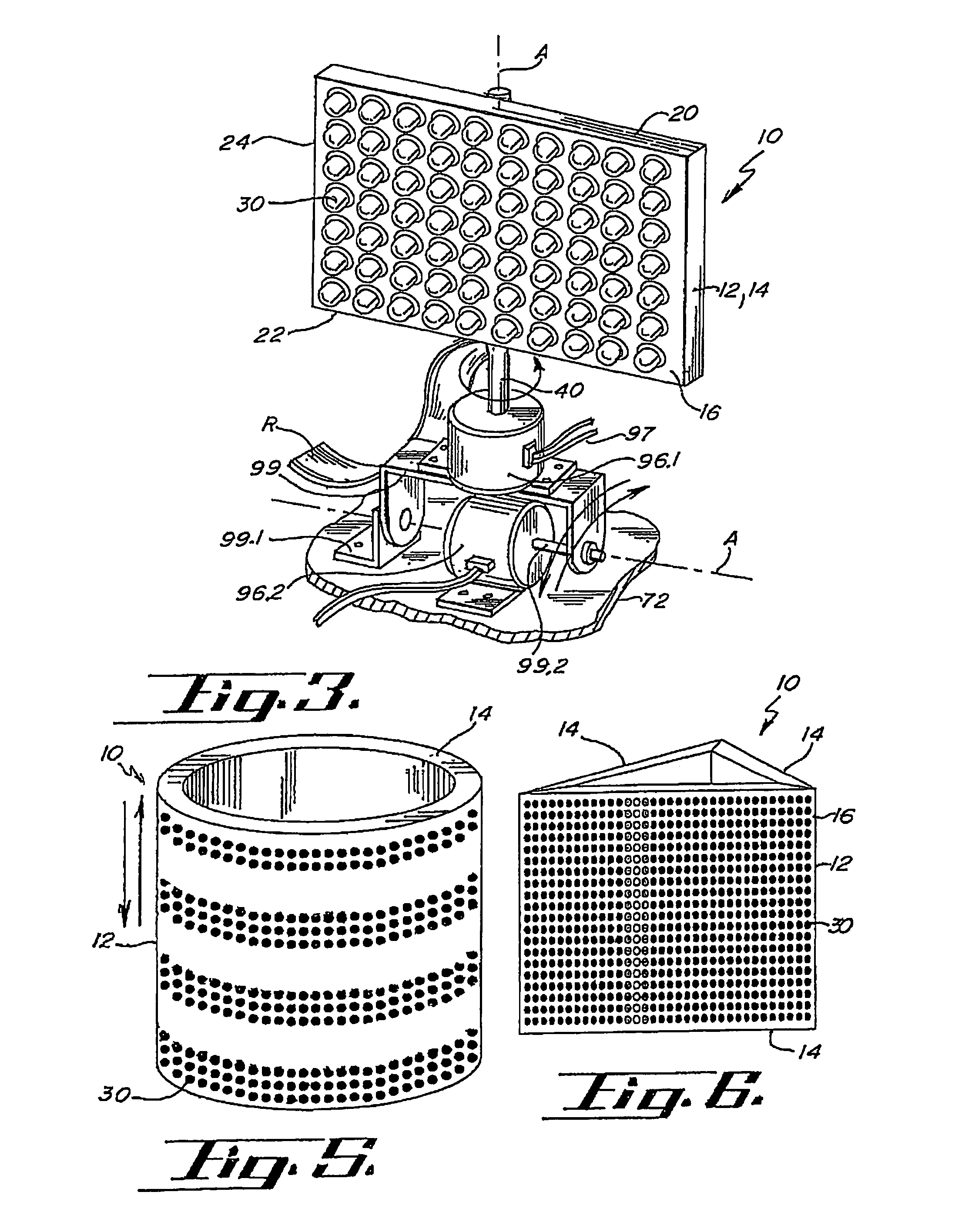Many problems exist with the known methods for producing warning light signals.
Additionally, these components increase the size of the light bar or emergency lights which may adversely affect the vehicles aerodynamic characteristics.
Moreover, there is an increased likelihood that a breakdown of the light bar or
light source will occur requiring the repair or replacement of the
defective component.
Finally, the known light bars and sources require a relatively large amount of
electrical current during operation.
The demands upon the electrical power
system for a vehicle may therefore exceed available electrical resources reducing optimization of performance.
These lamps emanate large amounts of heat which is difficult to dissipate from a sealed light
enclosure or
emergency light and which may damage the electronic circuitry contained therein.
In addition, these lamps consume large amounts of current requiring a large power supply or large battery or electrical source which may be especially problematic for use with a vehicle.
These lamps also generate substantial electromagnetic emissions which may interfere with
radio communications for a vehicle.
Finally, these lamps, which are not rugged, have relatively
short life cycles necessitating frequent replacement.
Another problem with the known warning signal lights is the use of filters to produce a desired color.
Furthermore, filters fade or flake over time rendering the filters unable to consistently produce a desired color for observation in an emergency situation.
These problems associated with traditional signaling lamps are exacerbated by the fact that creating multiple light signals requires multiple signaling lamps.
Further, there is little flexibility in modifying the
light signal created by a lamp.
For example, changing a stationary lamp into one that rotates or oscillates would require a substantial modification to the light bar which may not be physically or economically possible.
A problem with the prior art is the cost and
failure rate of the known “unmarked corner tubes,” or “dome lights.” The
failure rate of these devices frequently results in a significant amount of “down time” for a vehicle to effectuate replacement.
Further, an officer is frequently unaware that a vehicle light is inoperative requiring replacement.
This condition reduces the safety to an officer during the performance of his or her duties.
In addition, the reduced life cycle and
failure rate of the known illumination devices significantly increases
operational costs associated with material replacement and labor.
The color blue is particularly hard to produce in this manner.
Corrosive effects may destroy the trigger wire and the wire contacts leading to the
anode and
cathode.
Corrosion is enhanced because of the
high heat generating characteristics of the lamp which may heat the air inside the lamp fixture when the lamp is in use, and this heated air may condense when the lamp is off resulting in
moisture buildup inside the fixture.
The buildup of
moisture may result in the shorting out of the electrical wires and degrade the performance of the emission wire, sometimes preventing proper
ionization of the gas within the
xenon gas discharge lamp.
Warning lights, due to the type of
light source utilized, may be relatively large in size which in turn may have an adverse affect upon adjacent operational components.
In addition, there is an increased likelihood for a breakdown of the light source requiring repair or replacement of components.
Another problem with the known warning signal lights is the use of rotational and / or oscillating mechanisms which are utilized to impart a rotational or oscillating movement to a light source for observation during
emergency situations.
These
mechanical devices are frequently cumbersome and difficult to incorporate and couple onto various locations about a vehicle due to the size of the device.
These
mechanical devices also frequently require a relatively large power supply to engage and operate the device to impart rotational and / or oscillating movement for a light source.
Another problem with the known warning signal lights is the absence of flexibility for the provision of
variable intensity for the light sources to increase the number of available distinct and independent visual
light effects.
Further, no warning light signals are known which combine a desired type of light effect with either irregular variable
light intensity or regular modulated
light intensity to provide a unique and desired combination lighting effect.
It has also not been known to provide alternative
colored LED light sources which may be electrically controlled for the provision of any desired pattern of light signal such as flashing, pulsating, oscillating, modulating, rotational, alternating, strobe, and / or combination
light effects.
Other problems associated with the known warning signal lights relate to the restricted positioning on a vehicle due to the size and shape of the light source.
Light bars or light sources generally extended perpendicular to the longitudinal axis of a vehicle and were therefore more difficult to observe from the sides by an individual.
Observation from the sides, or at an
acute angle relative to the sides, frequently resulted in reduced observation of emergency lights during an emergency situation.
 Login to View More
Login to View More  Login to View More
Login to View More 


